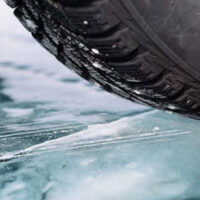The Hidden Danger of Black Ice: How to Stay Safe on New York Roads This Winter

Winter in New York can be unpredictable, with snowstorms, freezing rain, and frigid temperatures making roads hazardous. One of the most dangerous winter driving conditions is black ice—a nearly invisible layer of ice that can cause serious accidents in an instant. Understanding black ice, how to recognize it, and what to do if you encounter it can make all the difference in staying safe on the road.
What Is Black Ice?
Black ice is a thin, transparent layer of ice that forms on road surfaces when moisture freezes rapidly. Unlike snow or slush, black ice is nearly invisible because it blends in with the pavement. It typically forms overnight or early in the morning when temperatures drop below freezing, and can also develop in shaded areas, bridges, and overpasses where cold air circulates more freely.
Why Is Black Ice So Dangerous?
Black ice poses a unique risk to drivers because it is difficult to detect before it’s too late. Many drivers don’t realize they’ve hit black ice until their car starts sliding uncontrollably. This lack of warning makes it a leading cause of winter car accidents. Since it reduces traction almost completely, even experienced drivers can lose control if they don’t take the right precautions.
How to Identify Black Ice on the Road
While black ice is nearly invisible, there are a few signs that can help you anticipate where it might be:
- Glossy or wet-looking pavement in freezing temperatures – If the road appears wet but temperatures are below 32°F, it could be black ice.
- Lack of tire spray – On a cold, wet day, moving vehicles usually kick up water. If you notice a stretch of road where this isn’t happening, it may be covered in ice.
- Sudden loss of traction – If your steering feels light or your tires suddenly lose grip, you may have hit a patch of black ice.
What to Do If You Hit Black Ice
- Stay Calm – Panicking can make the situation worse.
- Do Not Slam the Brakes – This can cause your wheels to lock up and make skidding worse. Instead, gently ease off the accelerator.
- Steer Gently – If your car begins to slide, turn your steering wheel in the direction of the skid to regain control. Avoid overcorrecting, as that can cause a spinout.
- Keep a Steady Speed – If you’re traveling at a reasonable speed and have some control, avoid sudden movements until you pass the icy patch.
Preventing Black Ice Accidents
- Slow Down – The faster you’re going, the harder it is to recover from a skid.
- Increase Following Distance – Give extra space between you and the car ahead to allow more reaction time.
- Check Weather Reports – Stay informed about freezing conditions before heading out.
- Use Winter Tires – Tires with better tread and winter grip can reduce the risk of slipping.
- Avoid Sudden Movements – Smooth and controlled driving is key to avoiding loss of control.
Legal Recourse for Black Ice Accidents
Even though black ice is a natural hazard, liability for accidents can still exist. If a driver is speeding or not taking proper precautions, they may be found negligent. In some cases, municipalities or property owners could be responsible if they failed to properly maintain roads or parking lots.
If you or a loved one has been involved in a black ice-related accident, consulting with an experienced personal injury attorney can help determine your legal options. At Cohan Legal, we specialize in car accident cases and fight for the compensation you deserve.
